Module 1A: Problem Solving and Proportional Reasoning
Multiplying fractions, learning outcomes.
- Multiply two or more fractions
- Multiply a fraction by a whole number

Introduction
Before we get started, here is some important terminology that will help you understand the concepts about working with fractions in this section.
- product: the result of multiplication
- factor: something being multiplied – for [latex]3 \cdot 2 = 6[/latex] , both 3 and 2 are factors of 6
- numerator: the top part of a fraction – the numerator in the fraction [latex]\frac{2}{3}[/latex] is 2
- denominator: the bottom part of a fraction – the denominator in the fraction [latex]\frac{2}{3}[/latex] is 3
Note About Instructions
Many different words are used by math textbooks and teachers to provide students with instructions on what they are to do with a given problem. For example, you may see instructions such as “Find” or “Simplify” in the example in this module. It is important to understand what these words mean so you can successfully work through the problems in this course. Here is a short list of the words you may see that can help you know how to work through the problems in this module.
Multiply Fractions
Just as you add, subtract, multiply, and divide when working with whole numbers, you also use these operations when working with fractions. There are many times when it is necessary to multiply fractions. A model may help you understand multiplication of fractions.
When you multiply a fraction by a fraction, you are finding a “fraction of a fraction.” Suppose you have [latex]\frac{3}{4}[/latex] of a candy bar and you want to find [latex]\frac{1}{2}[/latex] of the [latex]\frac{3}{4}[/latex]:
By dividing each fourth in half, you can divide the candy bar into eighths.
Then, choose half of those to get [latex]\frac{3}{8}[/latex].
In both of the above cases, to find the answer, you can multiply the numerators together and the denominators together.
Multiplying Two Fractions
[latex] \frac{a}{b}\cdot \frac{c}{d}=\frac{a\cdot c}{b\cdot d}=\frac{\text{product of the numerators}}{\text{product of the denominators}}[/latex]
Multiplying More Than Two Fractions
[latex] \frac{a}{b}\cdot \frac{c}{d}\cdot \frac{e}{f}=\frac{a\cdot c\cdot e}{b\cdot d\cdot f}[/latex]
Multiply [latex] \frac{2}{3}\cdot \frac{4}{5}[/latex].
[latex] \frac{2\cdot 4}{3\cdot 5}[/latex]
Simplify, if possible. This fraction is already in lowest terms.
[latex] \frac{8}{15}[/latex]
To review: if a fraction has common factors in the numerator and denominator, we can reduce the fraction to its simplified form by removing the common factors.
For example,
- Given [latex] \frac{8}{15}[/latex], the factors of 8 are: 1, 2, 4, 8 and the factors of 15 are: 1, 3, 5, 15. [latex] \frac{8}{15}[/latex] is simplified because there are no common factors of 8 and 15 .
- Given [latex] \frac{10}{15}[/latex], the factors of 10 are: 1, 2, 5, 10 and the factors of15 are: 1, 3, 5, 15. [latex] \frac{10}{15}[/latex] is not simplified because 5 is a common factor of 10 and 15 .
You can simplify first, before you multiply two fractions, to make your work easier. This allows you to work with smaller numbers when you multiply.
In the following video you will see an example of how to multiply two fractions, then simplify the answer.
Think About It
Multiply [latex] \frac{2}{3}\cdot \frac{1}{4}\cdot\frac{3}{5}[/latex]. Simplify the answer.
What makes this example different than the previous ones on this page? Use the box below to write down a few thoughts about how you would multiply three fractions together.
[latex] \frac{2\cdot 1\cdot 3}{3\cdot 4\cdot 5}[/latex]
Simplify first by canceling (dividing) the common factors of 3 and 2. 3 divided by 3 is 1, and 2 divided by 2 is 1.
[latex]\begin{array}{c}\frac{2\cdot 1\cdot3}{3\cdot (2\cdot 2)\cdot 5}\\\frac{\cancel{2}\cdot 1\cdot\cancel{3}}{\cancel{3}\cdot (\cancel{2}\cdot 2)\cdot 5}\\\frac{1}{10}\end{array}[/latex]
[latex] \frac{2}{3}\cdot \frac{1}{4}\cdot\frac{3}{5}[/latex] = [latex]\frac{1}{10}[/latex]

Privacy Policy
If you're seeing this message, it means we're having trouble loading external resources on our website.
If you're behind a web filter, please make sure that the domains *.kastatic.org and *.kasandbox.org are unblocked.
To log in and use all the features of Khan Academy, please enable JavaScript in your browser.
Course: 5th grade > Unit 6
- Multiplying fractions word problem: muffins
- Multiplying fractions word problem: laundry
- Multiplying fractions word problem: bike
Multiply fractions word problems
- Multiply fractions: FAQ
- Your answer should be
- a proper fraction, like 1 / 2 or 6 / 10
- an improper fraction, like 10 / 7 or 14 / 8

Or search by topic
Number and algebra
- The Number System and Place Value
- Calculations and Numerical Methods
- Fractions, Decimals, Percentages, Ratio and Proportion
- Properties of Numbers
- Patterns, Sequences and Structure
- Algebraic expressions, equations and formulae
- Coordinates, Functions and Graphs
Geometry and measure
- Angles, Polygons, and Geometrical Proof
- 3D Geometry, Shape and Space
- Measuring and calculating with units
- Transformations and constructions
- Pythagoras and Trigonometry
- Vectors and Matrices
Probability and statistics
- Handling, Processing and Representing Data
- Probability
Working mathematically
- Thinking mathematically
- Mathematical mindsets
- Cross-curricular contexts
- Physical and digital manipulatives
For younger learners
- Early Years Foundation Stage
Advanced mathematics
- Decision Mathematics and Combinatorics
- Advanced Probability and Statistics
Published 2013 Revised 2019
Exploring Fractions
- The first group gives you some starting points to explore with your class, which are applicable to a wide range of ages. The tasks in this first group will build on children's current understanding of fractions and will help them get to grips with the concept of the part-whole relationship.
- The second group of tasks focuses on the progression of ideas associated with fractions, through a problem-solving lens. So, the tasks in this second group are curriculum-linked but crucially also offer opportunities for learners to develop their problem-solving and reasoning skills.
- are applicable to a range of ages;
- provide contexts in which to explore the part-whole relationship in depth;
- offer opportunities to develop conceptual understanding through talk.
HIGH SCHOOL
- ACT Tutoring
- SAT Tutoring
- PSAT Tutoring
- ASPIRE Tutoring
- SHSAT Tutoring
- STAAR Tutoring
GRADUATE SCHOOL
- MCAT Tutoring
- GRE Tutoring
- LSAT Tutoring
- GMAT Tutoring
- AIMS Tutoring
- HSPT Tutoring
- ISAT Tutoring
- SSAT Tutoring
Search 50+ Tests
Loading Page
math tutoring
- Elementary Math
- Pre-Calculus
- Trigonometry
science tutoring
Foreign languages.
- Mandarin Chinese
elementary tutoring
- Computer Science
Search 350+ Subjects
- Video Overview
- Tutor Selection Process
- Online Tutoring
- Mobile Tutoring
- Instant Tutoring
- How We Operate
- Our Guarantee
- Impact of Tutoring
- Reviews & Testimonials
- Media Coverage
- About Varsity Tutors
Common Core: 5th Grade Math : Solve Real World Problems Involving Multiplication of Fractions and Mixed Numbers: CCSS.Math.Content.5.NF.B.6
Study concepts, example questions & explanations for common core: 5th grade math, all common core: 5th grade math resources, example questions, example question #1 : solve real world problems involving multiplication of fractions and mixed numbers: ccss.math.content.5.nf.b.6.

Example Question #5 : Solve Real World Problems Involving Multiplication Of Fractions And Mixed Numbers: Ccss.Math.Content.5.Nf.B.6

Example Question #6 : Solve Real World Problems Involving Multiplication Of Fractions And Mixed Numbers: Ccss.Math.Content.5.Nf.B.6

Example Question #7 : Solve Real World Problems Involving Multiplication Of Fractions And Mixed Numbers: Ccss.Math.Content.5.Nf.B.6

Example Question #10 : Solve Real World Problems Involving Multiplication Of Fractions And Mixed Numbers: Ccss.Math.Content.5.Nf.B.6

Report an issue with this question
If you've found an issue with this question, please let us know. With the help of the community we can continue to improve our educational resources.
DMCA Complaint
If you believe that content available by means of the Website (as defined in our Terms of Service) infringes one or more of your copyrights, please notify us by providing a written notice (“Infringement Notice”) containing the information described below to the designated agent listed below. If Varsity Tutors takes action in response to an Infringement Notice, it will make a good faith attempt to contact the party that made such content available by means of the most recent email address, if any, provided by such party to Varsity Tutors.
Your Infringement Notice may be forwarded to the party that made the content available or to third parties such as ChillingEffects.org.
Please be advised that you will be liable for damages (including costs and attorneys’ fees) if you materially misrepresent that a product or activity is infringing your copyrights. Thus, if you are not sure content located on or linked-to by the Website infringes your copyright, you should consider first contacting an attorney.
Please follow these steps to file a notice:
You must include the following:
A physical or electronic signature of the copyright owner or a person authorized to act on their behalf; An identification of the copyright claimed to have been infringed; A description of the nature and exact location of the content that you claim to infringe your copyright, in \ sufficient detail to permit Varsity Tutors to find and positively identify that content; for example we require a link to the specific question (not just the name of the question) that contains the content and a description of which specific portion of the question – an image, a link, the text, etc – your complaint refers to; Your name, address, telephone number and email address; and A statement by you: (a) that you believe in good faith that the use of the content that you claim to infringe your copyright is not authorized by law, or by the copyright owner or such owner’s agent; (b) that all of the information contained in your Infringement Notice is accurate, and (c) under penalty of perjury, that you are either the copyright owner or a person authorized to act on their behalf.
Send your complaint to our designated agent at:
Charles Cohn Varsity Tutors LLC 101 S. Hanley Rd, Suite 300 St. Louis, MO 63105
Or fill out the form below:
Contact Information
Complaint details.


Reading & Math for K-5
- Kindergarten
- Learning numbers
- Comparing numbers
- Place Value
- Roman numerals
- Subtraction
- Multiplication
- Order of operations
- Drills & practice
- Measurement
- Factoring & prime factors
- Proportions
- Shape & geometry
- Data & graphing
- Word problems
- Children's stories
- Leveled Stories
- Context clues
- Cause & effect
- Compare & contrast
- Fact vs. fiction
- Fact vs. opinion
- Main idea & details
- Story elements
- Conclusions & inferences
- Sounds & phonics
- Words & vocabulary
- Reading comprehension
- Early writing
- Numbers & counting
- Simple math
- Social skills
- Other activities
- Dolch sight words
- Fry sight words
- Multiple meaning words
- Prefixes & suffixes
- Vocabulary cards
- Other parts of speech
- Punctuation
- Capitalization
- Narrative writing
- Opinion writing
- Informative writing
- Cursive alphabet
- Cursive letters
- Cursive letter joins
- Cursive words
- Cursive sentences
- Cursive passages
- Grammar & Writing
Breadcrumbs
- Word Problems
- Multiplying fractions
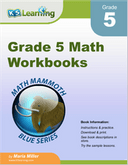
Download & Print From only $2.60
Multiplying fractions word problems
Including estimating.
These grade 5 word problems involve the multiplication of common fractions by other fractions or whole numbers. Some problems ask students between what numbers does the answer lie? Answers are simplified where possible.

These worksheets are available to members only.
Join K5 to save time, skip ads and access more content. Learn More
More word problem worksheets
Explore all of our math word problem worksheets , from kindergarten through grade 5.
What is K5?
K5 Learning offers free worksheets , flashcards and inexpensive workbooks for kids in kindergarten to grade 5. Become a member to access additional content and skip ads.
Our members helped us give away millions of worksheets last year.
We provide free educational materials to parents and teachers in over 100 countries. If you can, please consider purchasing a membership ($24/year) to support our efforts.
Members skip ads and access exclusive features.
Learn about member benefits
This content is available to members only.
- Forgot Password?

Multiplying Fractions Practice Questions
Click here for questions, click here for answers.
multiplication
GCSE Revision Cards

5-a-day Workbooks


Primary Study Cards

Privacy Policy
Terms and Conditions
Corbettmaths © 2012 – 2024

Home / United States / Math Classes / 5th Grade Math / Problem Solving using Fractions
Problem Solving using Fractions
Fractions are numbers that exist between whole numbers. We get fractions when we divide whole numbers into equal parts. Here we will learn to solve some real-life problems using fractions. ...Read More Read Less
Table of Contents

What are Fractions?
Types of fractions.
- Fractions with like and unlike denominators
- Operations on fractions
- Fractions can be multiplied by using
- Let’s take a look at a few examples
Solved Examples
- Frequently Asked Questions
Equal parts of a whole or a collection of things are represented by fractions . In other words a fraction is a part or a portion of the whole. When we divide something into equal pieces, each part becomes a fraction of the whole.
For example in the given figure, one pizza represents a whole. When cut into 2 equal parts, each part is half of the whole, that can be represented by the fraction \(\frac{1}{2}\) .
Similarly, if it is divided into 4 equal parts, then each part is one fourth of the whole, that can be represented by the fraction \(\frac{1}{4}\) .

Proper fractions
A fraction in which the numerator is less than the denominator value is called a proper fraction.
For example , \(\frac{3}{4}\) , \(\frac{5}{7}\) , \(\frac{3}{8}\) are proper fractions.
Improper fractions
A fraction with the numerator higher than or equal to the denominator is called an improper fraction .
Eg \(\frac{9}{4}\) , \(\frac{8}{8}\) , \(\frac{9}{4}\) are examples of improper fractions.
Mixed fractions
A mixed number or a mixed fraction is a type of fraction which is a combination of both a whole number and a proper fraction.
We express improper fractions as mixed numbers.
For example , 5\(\frac{1}{3}\) , 1\(\frac{4}{9}\) , 13\(\frac{7}{8}\) are mixed fractions.
Unit fraction
A unit fraction is a fraction with a numerator equal to one. If a whole or a collection is divided into equal parts, then exactly 1 part of the total parts represents a unit fraction .

Fractions with Like and Unlike Denominators
Like fractions are those in which two or more fractions have the same denominator, whereas unlike fractions are those in which the denominators of two or more fractions are different.
For example,
\(\frac{1}{4}\) and \(\frac{3}{4}\) are like fractions as they both have the same denominator, that is, 4.
\(\frac{1}{3}\) and \(\frac{1}{4}\) are unlike fractions as they both have a different denominator.
Operations on Fractions
We can perform addition, subtraction, multiplication and division operations on fractions.
Fractions with unlike denominators can be added or subtracted using equivalent fractions. Equivalent fractions can be obtained by finding a common denominator. And a common denominator is obtained either by determining a common multiple of the denominators or by calculating the product of the denominators.
There is another method to add or subtract mixed numbers, that is, solve the fractional and whole number parts separately, and then, find their sum to get the final answer.
Fractions can be Multiplied by Using:
Division operations on fractions can be performed using a tape diagram and area model. Also, when a fraction is divided by another fraction then we can solve it by multiplying the dividend with the reciprocal of the divisor.
Let’s Take a Look at a Few Examples
Addition and subtraction using common denominator
( \(\frac{1}{6} ~+ ~\frac{2}{5}\) )
We apply the method of equivalent fractions. For this we need a common denominator, or a common multiple of the two denominators 6 and 5, that is, 30.
\(\frac{1}{6} ~+ ~\frac{2}{5}\)
= \(\frac{5~+~12}{30}\)
= \(\frac{17}{30}\)
( \(\frac{5}{2}~-~\frac{1}{6}\) )
= \(\frac{12~-~5}{30}\)
= \(\frac{7}{30}\)
Examples of Multiplication and Division
Multiplication:
(\(\frac{1}{6}~\times~\frac{2}{5}\))
= (\(\frac{1~\times~2}{6~\times~5}\)) [Multiplying numerator of fractions and multiplying denominator of fractions]
= \(\frac{2}{30}\)
(\(\frac{2}{5}~÷~\frac{1}{6}\))
= (\(\frac{2 ~\times~ 5}{6~\times~ 1}\)) [Multiplying dividend with the reciprocal of divisor]
= (\(\frac{2 ~\times~ 6}{5 ~\times~ 1}\))
= \(\frac{12}{5}\)
Example 1: Solve \(\frac{7}{8}\) + \(\frac{2}{3}\)
Let’s add \(\frac{7}{8}\) and \(\frac{2}{3}\) using equivalent fractions. For this we need to find a common denominator or a common multiple of the two denominators 8 and 3, which is, 24.
\(\frac{7}{8}\) + \(\frac{2}{3}\)
= \(\frac{21~+~16}{24}\)
= \(\frac{37}{24}\)
Example 2: Solve \(\frac{11}{13}\) – \(\frac{12}{17}\)
Solution:
Let’s subtract \(\frac{12}{17}\) from \(\frac{11}{13}\) using equivalent fractions. For this we need a common denominator or a common multiple of the two denominators 13 and 17, that is, 221.
\(\frac{11}{13}\) – \(\frac{12}{17}\)
= \(\frac{187~-~156}{221}\)
= \(\frac{31}{221}\)
Example 3: Solve \(\frac{15}{13} ~\times~\frac{18}{17}\)
Multiply the numerators and multiply the denominators of the 2 fractions.
\(\frac{15}{13}~\times~\frac{18}{17}\)
= \(\frac{15~~\times~18}{13~~\times~~17}\)
= \(\frac{270}{221}\)
Example 4: Solve \(\frac{25}{33}~\div~\frac{41}{45}\)
Divide by multiplying the dividend with the reciprocal of the divisor.
\(\frac{25}{33}~\div~\frac{41}{45}\)
= \(\frac{25}{33}~\times~\frac{41}{45}\) [Multiply with reciprocal of the divisor \(\frac{41}{45}\) , that is, \(\frac{45}{41}\) ]
= \(\frac{25~\times~45}{33~\times~41}\)
= \(\frac{1125}{1353}\)
Example 5:
Sam was left with \(\frac{7}{8}\) slices of chocolate cake and \(\frac{3}{7}\) slices of vanilla cake after he shared the rest with his friends. Find out the total number of slices of cake he had with him. Sam shared \(\frac{10}{11}\) slices from the total number he had with his parents. What is the number of slices he has remaining?
To find the total number of slices of cake he had after sharing we need to add the slices of each cake he had,
= \(\frac{7}{8}\) + \(\frac{3}{7}\)
= \(\frac{49~+~24}{56}\)
= \(\frac{73}{56}\)
To find out the remaining number of slices Sam has \(\frac{10}{11}\) slices need to be deducted from the total number,
= \(\frac{73}{56}~-~\frac{10}{11}\)
= \(\frac{803~-~560}{616}\)
= \(\frac{243}{616}\)
Hence, after sharing the cake with his friends, Sam has \(\frac{73}{56}\) slices of cake, and after sharing with his parents he had \(\frac{243}{616}\) slices of cake left with him.
Example 6: Tiffany squeezed oranges to make orange juice for her juice stand. She was able to get 25 ml from one orange. How many oranges does she need to squeeze to fill a jar of \(\frac{15}{8}\) liters? Each cup that she sells carries 200 ml and she sells each cup for 64 cents. How much money does she make at her juice stand?
First \(\frac{15}{8}\) l needs to be converted to milliliters.
\(\frac{15}{8}\)l into milliliters = \(\frac{15}{8}\) x 1000 = 1875 ml
To find the number of oranges, divide the total required quantity by the quantity of juice that one orange can give.
The number of oranges required for 1875 m l of juice = \(\frac{1875}{25}\) ml = 75 oranges
To find the number of cups she sells, the total quantity of juice is to be divided by the quantity of juice that 1 cup has
= \(\frac{1875}{200}~=~9\frac{3}{8}\) cups
We know that, the number of cups cannot be a fraction, it has to be a whole number. Also each cup must have 200ml. Hence with the quantity of juice she has she can sell 9 cups, \(\frac{3}{8}\) th of a cup cannot be sold alone.
Money made on selling 9 cups = 9 x 64 = 576 cents
Hence she makes 576 cents from her juice stand.
What is a mixed fraction?
A mixed fraction is a number that has a whole number and a fractional part. It is used to represent values between whole numbers.
How will you add fractions with unlike denominators?
When adding fractions with unlike denominators, take the common multiple of the denominators of both the fractions and then convert them into equivalent fractions.
Check out our other courses
Grades 1 - 12
Level 1 - 10

- Home Learning
- Free Resources
- New Resources
- Free resources
- New resources
- Filter resources
- Childrens mental health
- Easter resources
Internet Explorer is out of date!
For greater security and performance, please consider updating to one of the following free browsers
Multiply Unit Fractions by an Integer Lesson
This Year 5 Multiply Unit Fractions by an Integer lesson covers the prior learning of adding 2 or more fractions, before moving onto the main skill of multiplying unit fractions by an integer.
The lesson starts with a prior learning worksheet to check pupils’ understanding. The interactive lesson slides recap the prior learning before moving on to the main skill. Children can then practise further by completing the activities and can extend their learning by completing an engaging extension task.
National Curriculum Objective Mathematics Year 5: (5F5) Multiply proper fractions and mixed numbers by whole numbers, supported by materials and diagrams
Mathematics Year 5: (5F2a) Recognise mixed numbers and improper fractions and convert from one form to the other and write mathematical statements > 1 as a mixed number [for example, 2/5 + 4/5 = 6/5 = 1 1/5 ]
Mathematics Year 5: (5F2b) Identify, name and write equivalent fractions of a given fraction, represented visually, including tenths and hundredths
Get the most from lessons!

Resources for teachers

Interactive activities for children
2 Teaching Support
Subscription

Lesson Slides
These lesson slides guides pupils through the prior learning of adding 2 or more fractions, before moving onto the main skill of multiply unit fractions by an integer. There are a number of questions to check pupils' understanding throughout.
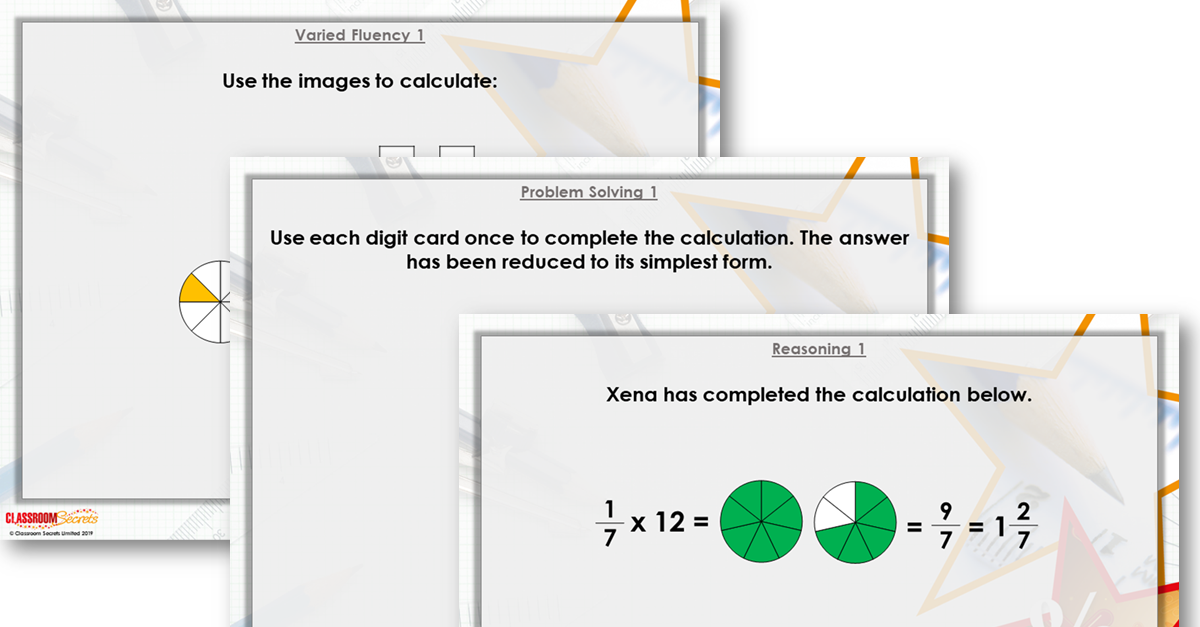
Modelling PowerPoint
This powerpoint can be used to model the questions that the children will complete on the Varied Fluency and Reasoning & Problem Solving worksheets as part of this lesson.
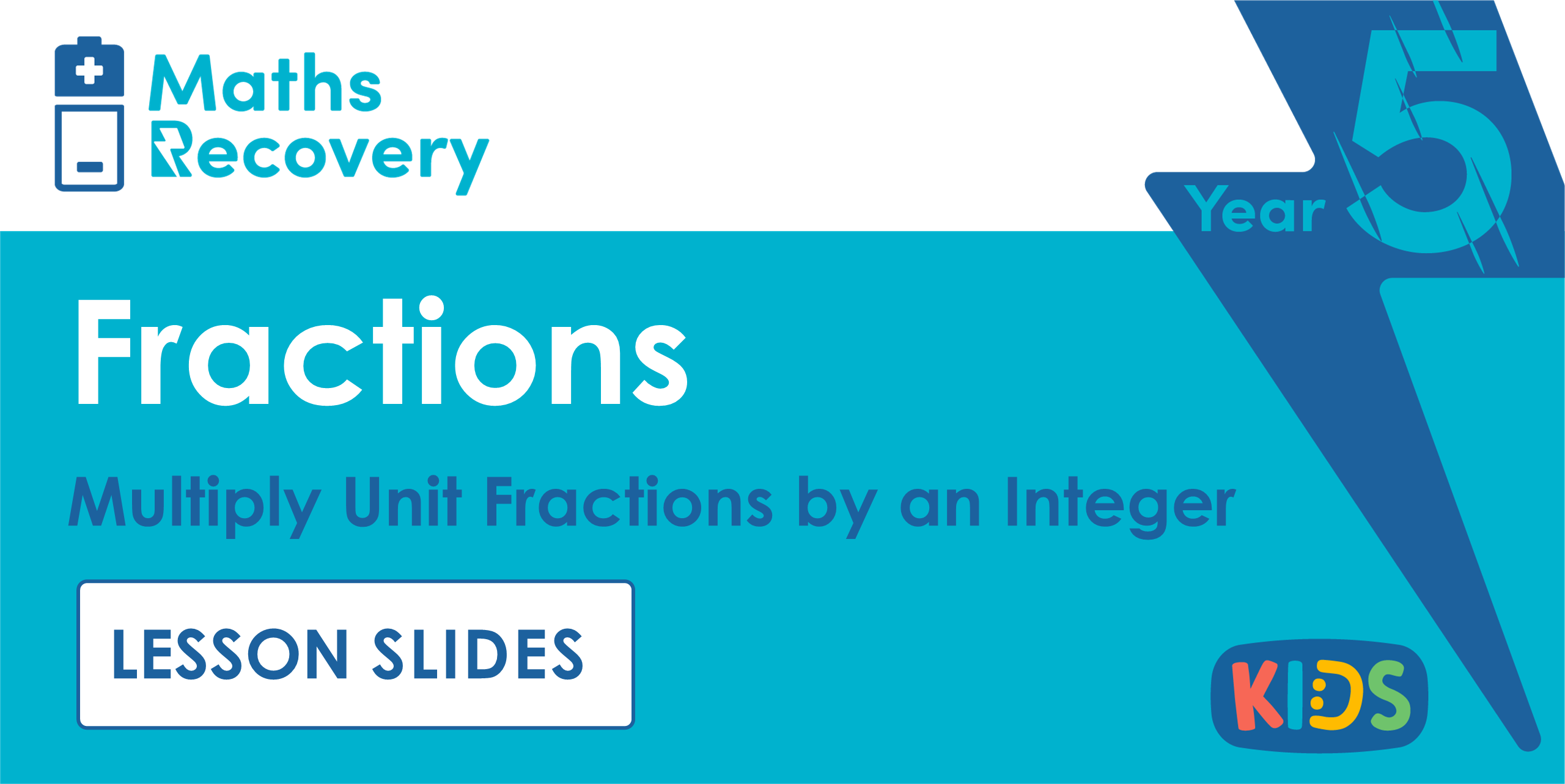
These are the same as the lesson slides on Classroom Secrets. You can assign this as an activity for pupils to access individually in school or remotely from home.
1 Prior Learning
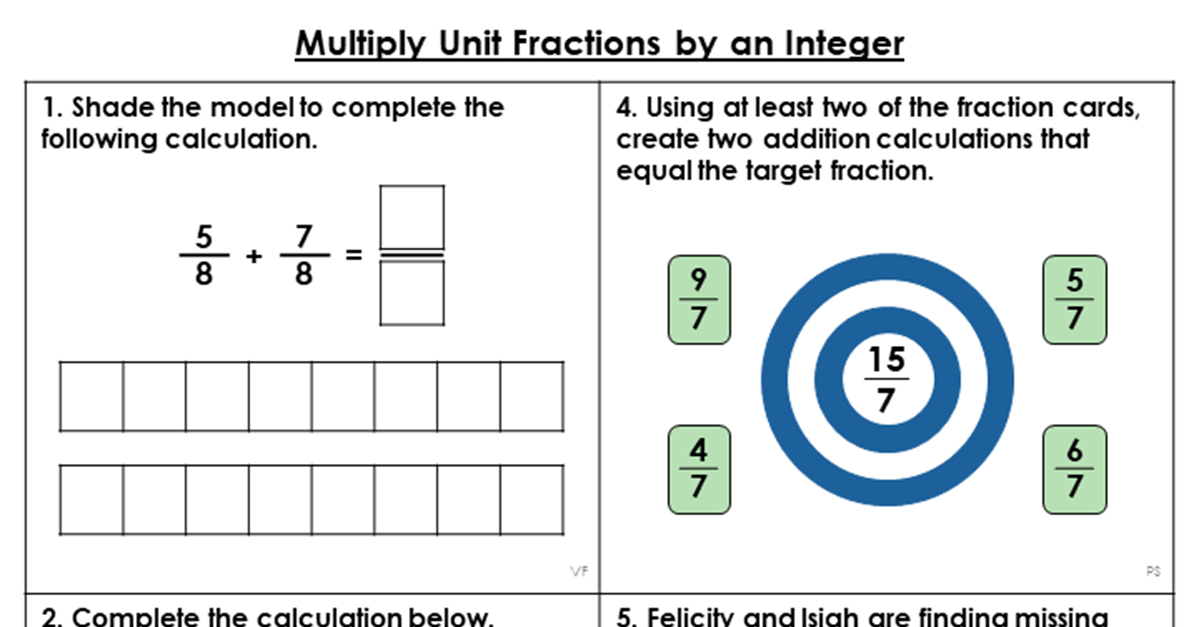
This worksheet recaps prior learning of adding 2 or more fractions, before moving onto the main skill of multiplying unit fractions by an integer.
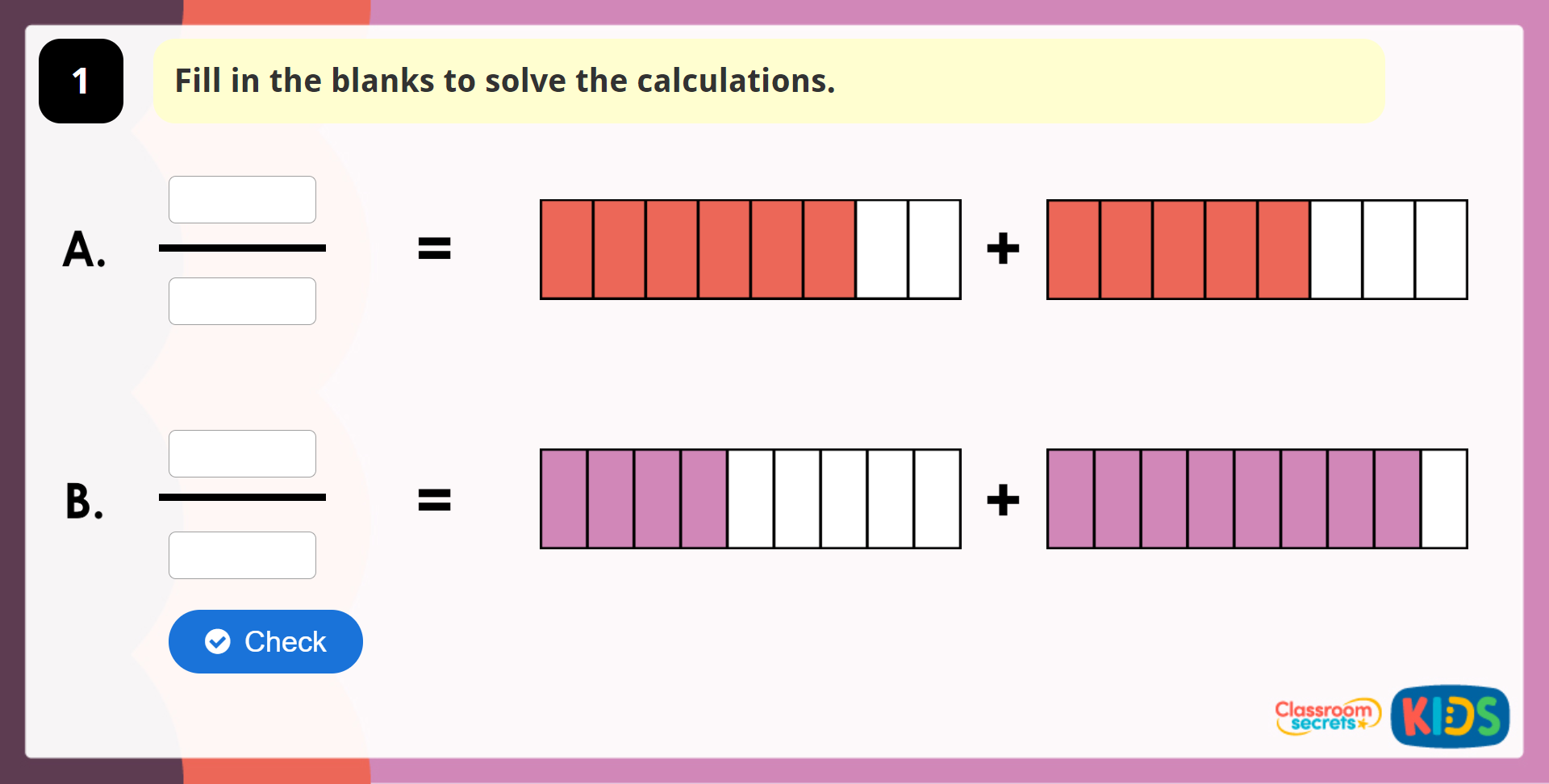
Interactive Activity
This Year 4 Add 2 or More Fractions Game checks pupils' understanding of adding 2 or more fractions together where the denominators are the same.
2 Practical Activities
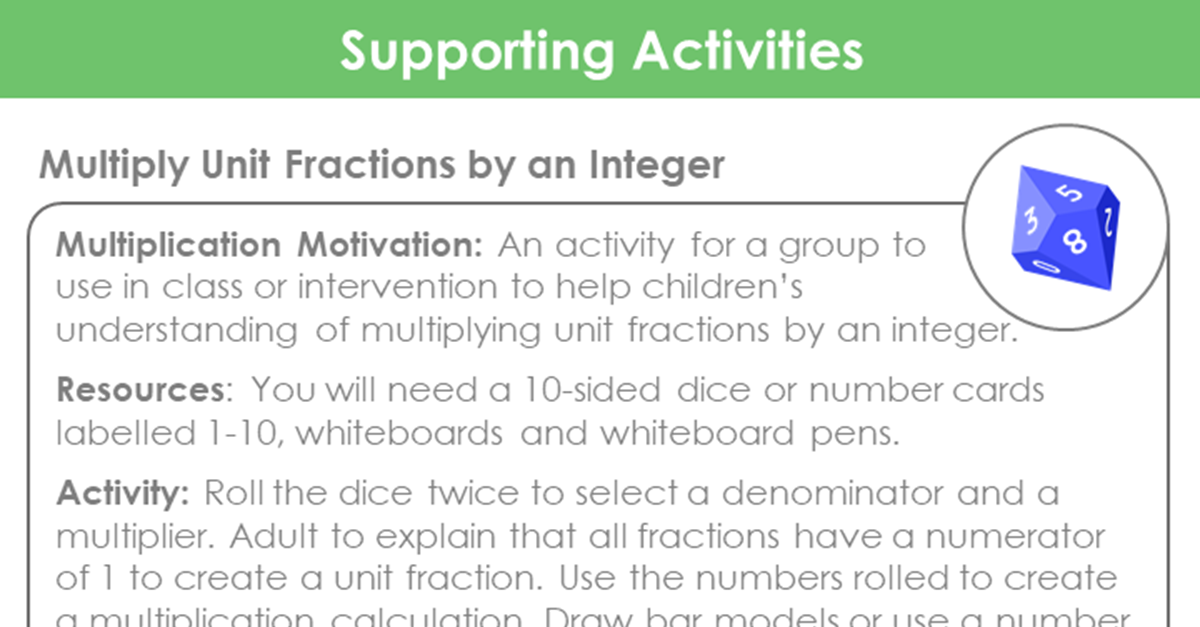
Supporting Activity
This the Multiply Unit Fractions by an Integer supporting activities sheet contains suggestions for additional tasks you might wish to use to support pupils' understanding of the concepts taught in the lesson.
2 Varied Fluency

This differentiated worksheet includes varied fluency questions for pupils to practise the main skill of this lesson.

Interactive Animation Activity
This Year 5 Multiply Unit Fractions by an Integer Interactive Animation supports pupils’ understanding of multiplying fractions including where the answer needs to be converted into a mixed number.
2 Reasoning & Problem Solving
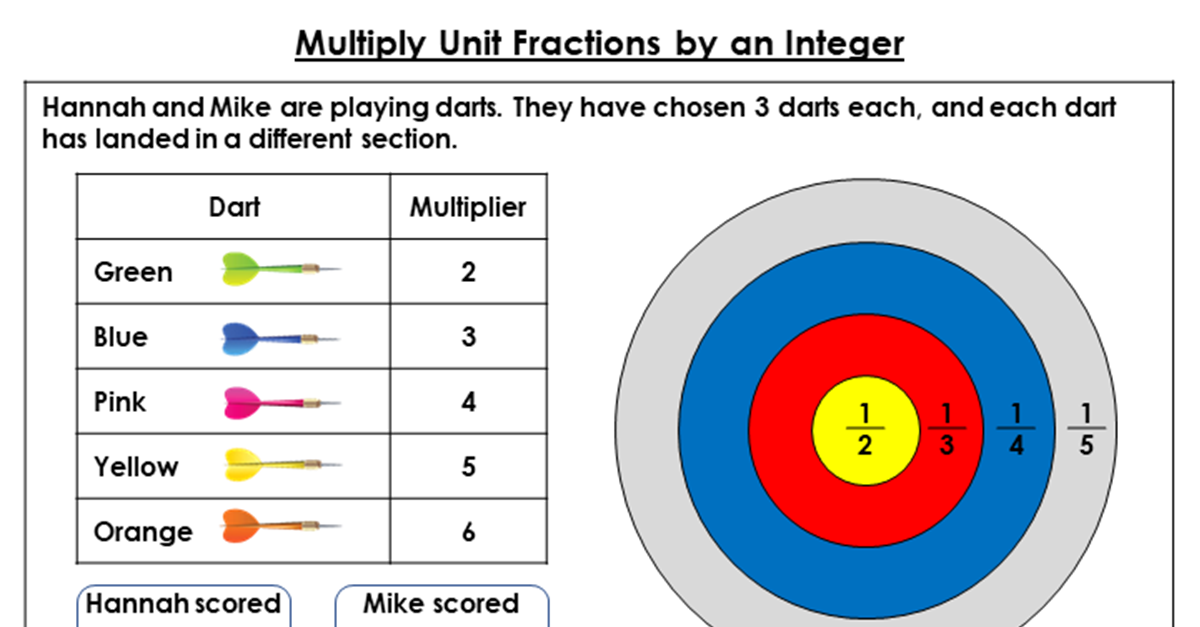
This multiply unit fractions by an integer extension task includes a challenge activity which can be used to further pupils' understanding of the concepts taught in the multiply unit fractions by an integer lesson.
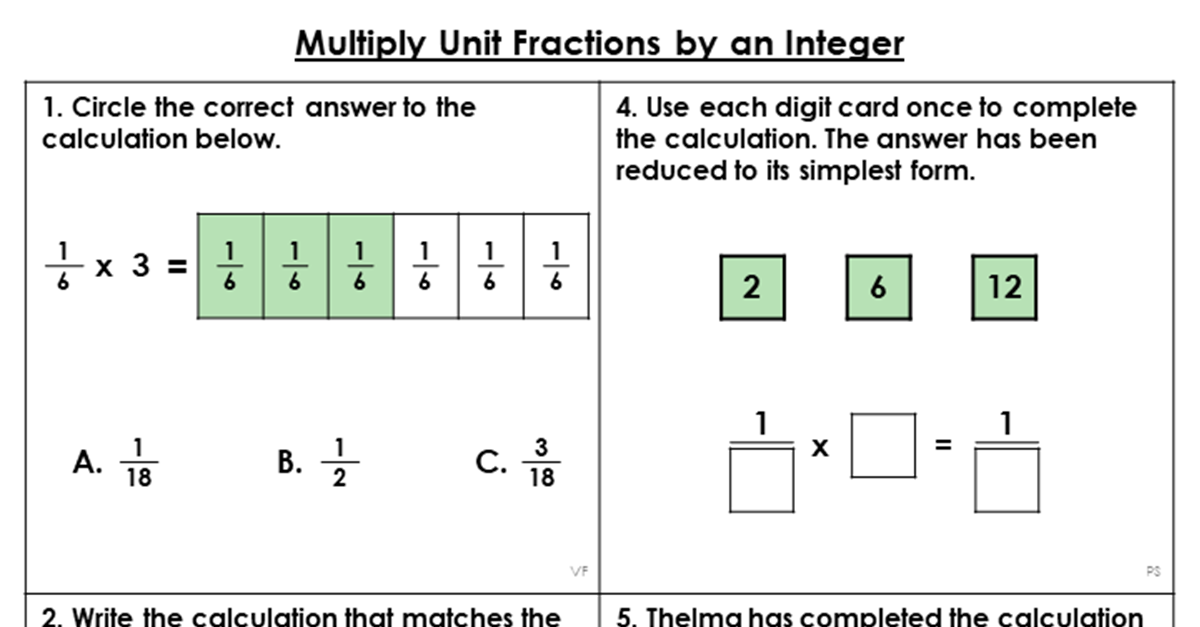
Mixed Practice
This worksheet includes varied fluency, reasoning and problem solving questions for pupils to practise the main skill of multiply unit fractions by an integer.
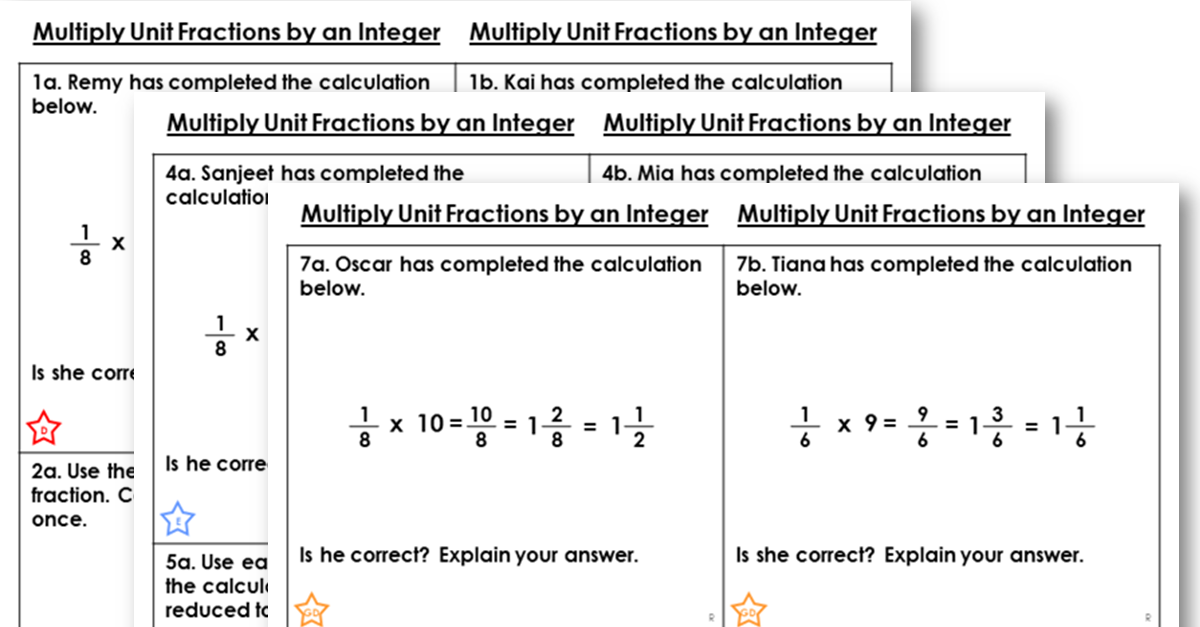
This differentiated worksheet includes reasoning and problem solving questions to support the teaching of this step.
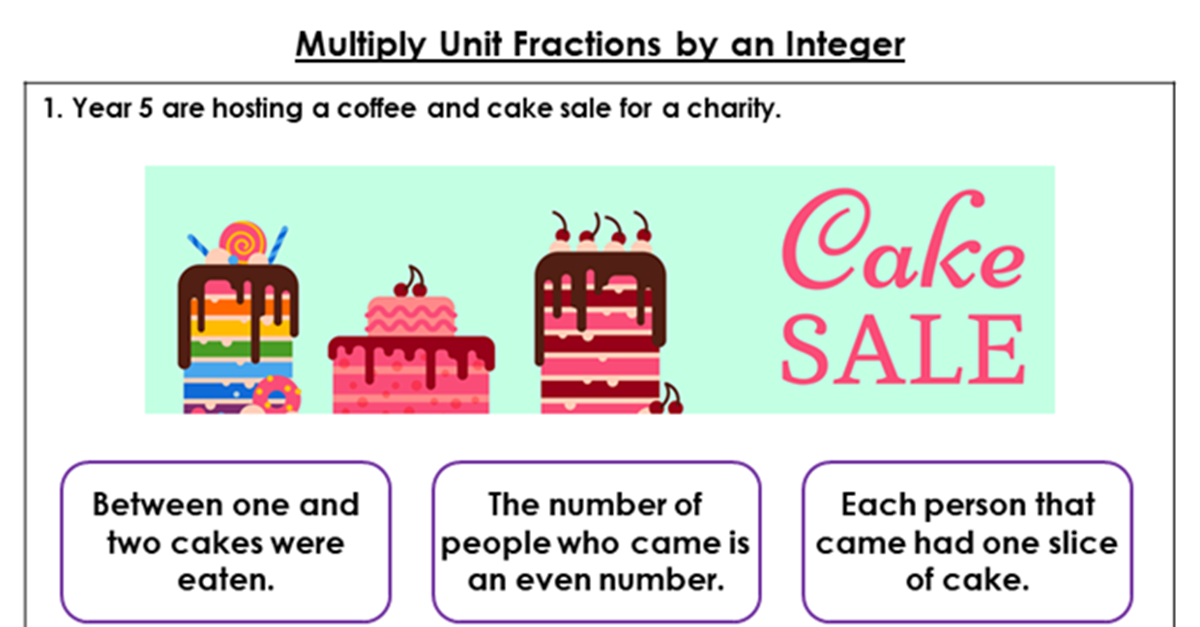
Discussion Problem
This worksheet includes two discussion problems which can be used in pairs or small groups to further pupils' understanding of the concepts taught in this lesson.

Interactive Challenge Activity
This Year 5 Multiply Unit Fractions by an Integer Maths Challenge checks pupils' understanding of multiplying unit fractions within a problem solving context. Pupils will sort the fractions based on the given criteria.
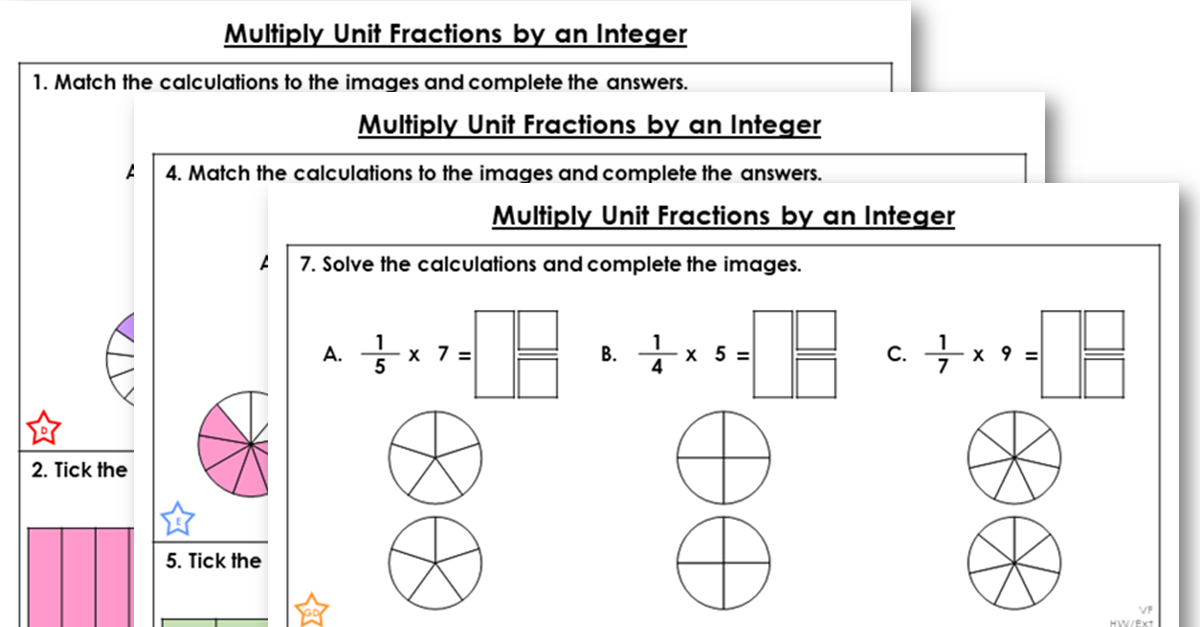
This differentiated worksheet includes varied fluency and reasoning and problem solving questions to support the teaching of this step.
2 Additional Activities

Consolidation Pack
These Fractions worksheets are fantastic at helping your pupils practice their reasoning and problem solving skills. This pack contains two different question types for Year 5 Spring Block 2.

Home Learning Pack
This Spring week 9 Maths pack contains varied fluency, reasoning and problem solving worksheets
D Download Packs
Stay in touch.
01422 419608
[email protected]
Interested in getting weekly updates from us? Then sign up to our newsletter here!

Information

- Cookie Policy
- Privacy Policy
- Terms and Conditions
Copyright: Classroom Secrets 2024
Company number: 8401067
VAT number: 248 8245 74
- Terms & Conditions
Designed by Classroom Secrets
- International
- Schools directory
- Resources Jobs Schools directory News Search

Multiplying Fractions in Context - Worded Problems
Subject: Mathematics
Age range: 11-14
Resource type: Worksheet/Activity
Last updated
18 November 2022
- Share through email
- Share through twitter
- Share through linkedin
- Share through facebook
- Share through pinterest

Creative Commons "Sharealike"
Your rating is required to reflect your happiness.
It's good to leave some feedback.
Something went wrong, please try again later.
Thank you so much for sharing your resources!
Empty reply does not make any sense for the end user
Just what I needed - thank you for posing a great free resource!
Thank you; I like the way these are more challenging than they seem at first - they'll really need to read the question. And thank you for being free.
jelenazoria
Report this resource to let us know if it violates our terms and conditions. Our customer service team will review your report and will be in touch.
Not quite what you were looking for? Search by keyword to find the right resource:

IMAGES
VIDEO
COMMENTS
Accept any 8 pairs of proper and improper fractions which multiply together to give the correct answer, for example: 6 13 78. x =. 3 8 24. 9b. He has multiplied both 17 and 13 by 6, instead of multiplying 17 by 6 and 13 by 7. The answer should be: 102 11 or 1. 91 91. Reasoning and Problem Solving - Multiply Fractions by Fractions ANSWERS.
A model may help you understand multiplication of fractions. When you multiply a fraction by a fraction, you are finding a "fraction of a fraction.". Suppose you have 3 4 3 4 of a candy bar and you want to find 1 2 1 2 of the 3 4 3 4: By dividing each fourth in half, you can divide the candy bar into eighths. Then, choose half of those to ...
Report a problem. Learn for free about math, art, computer programming, economics, physics, chemistry, biology, medicine, finance, history, and more. Khan Academy is a nonprofit with the mission of providing a free, world-class education for anyone, anywhere.
Exploring Fractions. Introduction. At NRICH, our aim is to offer rich tasks which develop deep understanding of mathematical concepts. Of course, by their very nature, rich tasks will also provide opportunities for children to work like a mathematician and so help them develop their problem-solving skills alongside this conceptual understanding.
Explanation: . When we multiply a fraction by a whole number, we first want to make the whole number into a fraction. We do that by putting the whole number over Then we multiply like normal. Because can go into only time and is left over. Karen collected bags of leaves.
Including estimating. These grade 5 word problems involve the multiplication of common fractions by other fractions or whole numbers. Some problems ask students between what numbers does the answer lie? Answers are simplified where possible. Worksheet #1 Worksheet #2 Worksheet #3 Worksheet #4. Worksheet #5 Worksheet #6.
multiplication. Practice Questions. Previous: Increasing/Decreasing by a Fraction Practice Questions. Next: Conversion Graphs Practice Questions. The Corbettmaths Practice Questions on Multiplying Fractions.
Proper fractions and improper fractions are multiplied by integers. Children create their own pictorial representations and answers must be a simplified mixed number. Questions 3, 6 and 9 (Problem Solving) Developing Calculate how many weeks of practice are needed to reach a minimum target. Mixed numbers are multiplied by integers.
Multiplying / Multiplication of Fractions Problem Solving Mastery Worksheet. Subject: Mathematics. Age range: 14-16. Resource type: Worksheet/Activity. File previews. pdf, 98.07 KB. pdf, 107.13 KB. This is a mastery worksheet on Multiplication of Fractions that includes questions on fluency, reasoning and problem solving. This worksheet aims to ...
This comprehensive teaching pack has been written in line with Version 3.0 of the White Rose Maths scheme of learning for year 6 autumn term block 4 small step 2: Multiply Fractions by Fractions. Included in the pack is an easy-to-follow PowerPoint containing fluency, reasoning and problem-solving activities for your children to work through together. The accompanying activity sheets follow ...
Mathematics Year 6: (6F2) Use common factors to simplify fractions; use common multiples to express fractions in the same denomination Mathematics Year 6: (6F3) Compare and order fractions, including fractions > 1 Mathematics Year 6: (6F4) Add and subtract fractions with different denominators and mixed numbers, using the concept of equivalent ...
The worksheet has three sections: Varied Fluency, Further Fluency and Reasoning and Problem Solving. The 'Varied Fluency' and 'Further Fluency' sections, which are designed using similar representations found in the White Rose Schemes, are intended to be sliced and placed into one half of the learner's exercise book, leaving the other ...
Problem solving. Caleb multiplies a unit fraction by a whole number. The denominator of the fraction is a factor of 12. The answer is greater than 1 but less than 2. The whole number is a factor of 18
Multiplication of numerators, and multiplication of denominators of the two fractions. Division operations on fractions can be performed using a tape diagram and area model. Also, when a fraction is divided by another fraction then we can solve it by multiplying the dividend with the reciprocal of the divisor.
Reasoning and Problem Solving Multiply Non-Unit Fractions by an Integer Reasoning and Problem Solving Multiply Non-Unit Fractions by an Integer Developing 1a. A is the odd one out as it equals . All the rest equal or . 2a. Rosie is correct. Todd has added the integer to the numerator and denominator. 3a. or Expected 4a.
Tick the box on the ruler which shows the two. 10. places where you would need to cut the fabric. 1 metre ruler. Reasoning and Problem Solving - Year 6 - Consolidation Pack -- Secure. Reasoning and Problem Solving - Fractions Consolidation - Year 6. 5. The carpet layer has sent his bill, he spent 2 5 hours cutting the carpet and.
Fractions mastery and problem solving. Subject: Mathematics. Age range: 11-14. Resource type: Worksheet/Activity. File previews. docx, 282.01 KB. pptx, 1.87 MB. Multiplying, dividing, adding and subtracting fractions mastery lesson including problem solving from nrich. If there are any mistakes on the answers, let me know and I can update.
Mathematics Year 5: (5F2a) Recognise mixed numbers and improper fractions and convert from one form to the other and write mathematical statements > 1 as a mixed number [for example, 2/5 + 4/5 = 6/5 = 1 1/5 ] Mathematics Year 5: (5F2b) Identify, name and write equivalent fractions of a given fraction, represented visually, including tenths and ...
This wonderful teaching pack has been written in line with Version 3.0 of the White Rose Maths scheme of learning for year 6 autumn term block 4 small step 1: Multiply Fractions by Integers. In the pack is an easy-to-follow PowerPoint containing fluency, reasoning and problem-solving activities for your children to work through together.
Multiplying Fractions in Context - Worded Problems. Subject: Mathematics. Age range: 11-14. Resource type: Worksheet/Activity. File previews. pdf, 11.79 MB. A collection of calculating fractions through worded problems in real life contexts. Great way to test comprehension of fraction calculations to KS3, nice starter for KS4 as a precursor to ...